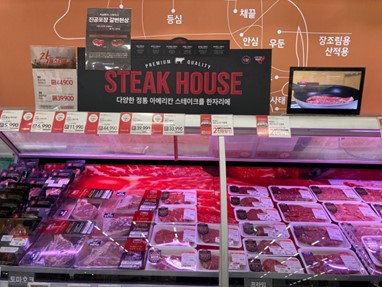South Korea opens duty-free quota for imported beef
United States is largest supplier in chilled and frozen beef.
August 9, 2022

South Korea is currently the leading value market for U.S. beef exports, with shipments on pace to possibly reach $3 billion in 2022. But rising food prices are a concern in Korea, and the government is taking steps to ease the burden on consumers. As part of this effort, Korea recently opened a 100,000 metric ton duty-free quota on imported beef, open to all eligible suppliers.
U.S. Meat Export Federation Vice President for Economic Analysis Erin Borror explains that the quota includes 25,000 mt of chilled beef and 75,000 mt of frozen beef. The United States is the largest supplier in both categories but captures an especially strong share of Korea's chilled beef market.
"Korea's chilled imports in the first half of the year totaled about 54,000 tons. The U.S. supplied 66% of those chilled beef imports, so we are the big supplier of chilled volume," Borror says. "The U.S. is also the biggest supplier of frozen beef. We had just over 50% of Korea's frozen imports in the first half of the year."
Under the Korea-U.S. Free Trade Agreement, U.S. beef has a tariff rate advantage over major competitors in Korea. All major beef suppliers will eventually reach zero duty, but the U.S. has a head start because KORUS entered into force earlier than other free trade agreements.
"Our tariff, at 10.7%, is lower that Australia's 16% and New Zealand and Canada at 18.6%. The other relevant suppliers that don't have free trade agreements are Mexico and Uruguay, they pay the full 40%. But when we think about everyone going to zero, it’s still a win for the U.S.," Borror says. "Yes, we lose our relative advantage, but if you think about that cost savings on U.S. beef, it's a benefit for the Korean importer and then is passed on to the Korean consumer. You know, a 10.7% tariff basically equates to about 70 cents per pound on chilled beef from the U.S., and equates to about 43 cents per pound on frozen U.S. beef."
Through June, U.S. beef exports to Korea are on a record pace at $1.52 billion, while global exports reached $6.19 billion. A detailed summary of January-June exports of U.S. beef, pork and lamb is available from the USMEF website.
Source: U.S. Meat Export Federation, which is solely responsible for the information provided, and wholly owns the information. Informa Business Media and all its subsidiaries are not responsible for any of the content contained in this information asset.
About the Author(s)
You May Also Like


.png?width=300&auto=webp&quality=80&disable=upscale)
